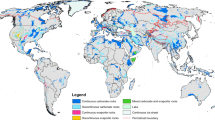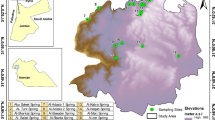Abstract
The study area of Tang sorkh Aquifer is located on the northern flank of the Derak anticline, a part of the Zagros Mountain Range, in the central-south of Iran. The study area is limited to undifferentiated non-salt Gachsaran Formation (NSGF), mainly composed of alternative layers of marl and marlstone, and gypsum. This paper is focused on the hydrogeological and hydrochemistry characteristics of the NSGF. A detailed geological cross section, perpendicular to the strike of the GF was prepared by detailed field surveying. The thickness of GF is 1,268 m, with 82 alternative units of marl, marlstone, gypsum, sandstone and limestone. The sub-aquifers are limited to four limestone, five gypsum, and one gypsum-halite units. The waters of these sub-aquifers emerge as springs or seepage into the Tang sorkh River (TR). The average discharge of springs emerging from limestone and gypsum units ranges between 0.3–8.4 and 0.5–0.75 l s−1, respectively. The source for sub-aquifers is mainly recharge from precipitation or river water. Marly layers disconnect the hydraulic connection between the sub-aquifers, directing the general flow parallel to the strikes. The lack of sinkholes and caves in the gypsum units is due to the small thickness of sub-aquifers, and consequently, low amounts of recharge water. The springs are classified into four groups based on their lithology, electrical conductivity, type of water, and trend of ion-concentration. The type of water in most of the springs is calcium-sulfate. The electrical conductivity is the main parameter to differentiate the hydrochemistry of the groups. The hydrochemistry of springs depends on the recharge from the TR, and the lithology of sub-aquifers and their adjacent units.






Similar content being viewed by others
References
Aghanabati A (2004) Geology of Iran. Geological Society of Iran, Tehran
Aghdam J (2012) Hydrogeology of gypsum formations in the south of Iran. University of Shiraz, Iran, Ph.D. dissertation
Ashjari J, Raeisi E (2006) Lithological control on water chemistry in karst aquifers of the Zagros Range. Iran. Cave and karst Scie 33(3):111–118
Bahroudi A, Koyi HA (2004) Tectonic-sedimentary framework of the gachsaran formation in the Zagros foreland basin. J. Mar and Petrol Geol 21:1295–1310
Dunnington HV (1968) Salt-tectonic features of Northern Iraq. In R. B. Mattox (Ed.), Saline deposits: A symposium based on papers from the International Conference on Saline Deposits. Geological Society of America (GSA), Special Paper 88. Houston, TX
Edgell HS (1996) Salt tectonics in the Persian Gulf basin. In G. L. Alsop, D. L. Blundell, & I. Davison (Eds.), Salt tectonics. Geological Society of Londan, Special Publication 100
Falcon NL (1967) The geology of the north-east margin of the Arabian basement shield. Advance Science London, pp. 31–42
James GA, Wynd JD (1965) Stratigraphic Nomenclture of Iranian Oil Consortium Agreement Area. Am Assoc Petrol Geol Bull 49(12):2182–2245
Johnson KS (1981) Dissolution of salt on the east flank of the Permian Basin in the southwestern USA. J Hydrol 54:75–93
Johnson KS (1997) Evaporite karst in the United States. Carbonates and Evap 12(1):2–14
Johnson KS (2003) Evaporite-karst problems in the United States. In: Johnson KS, Neal JT (eds) Evaporite karst and engineering/environmental problems in the United States. Okla Geol Surv Circ,vol 109:1–20
Johnson KS (2008) Evaporite-Karst problems and studies in the USA. J Environ Geol 53:937–943
Martinez JD, Johnson KS, Neal JT (1998) Sinkholes in evaporate rocks. Am Sci 86:38–51
Murris RJ (1980) Middle East: stratigraphic evolution and oil habitat. Am Assoc Petrol Geol Bull 64:597–618
O’Brien CAE (1957) Salt diapirism in South Persia. Geol en Mijnbouw 19:337–376
Oveisi B (2001) Resume of Kelestan geological map report. G.S.I.. Scale 1:100000, sheet N. 6449
Raeisi E, Moore F (1993) Hydrochemistry of Karst Springs from Two Carbonates Units in Zagros sides of Iran. J Sci, Islamic Repub Iran 4:302–307
Sto¨cklin J (1968) Salt deposits of the Middle East. In R. B. Mattox (Ed.), Saline deposits: A symposium based on papers from the International Conference on Saline Deposits. GSA, Special Paper 88. Houston, Texas
Stocklin J, Setudehnia A (1977) Stratigraphic lexicon of Iran. GSI, Tehran 370 p
Acknowledgments
This research was supported financially by Shiraz University. The authors would like to thank the Karst Research Center of Iran and the Fars Regional Water Authority for providing us with data.
Author information
Authors and Affiliations
Corresponding author
Rights and permissions
About this article
Cite this article
Aghdam, J.A., Raeisi, E., Zare, M. et al. Hydrogeology of non-salt Gachsaran Formation in Iran: an example from the Zagros Range–Tang sorkh Valley. Carbonates Evaporites 28, 309–319 (2013). https://doi.org/10.1007/s13146-012-0113-6
Accepted:
Published:
Issue Date:
DOI: https://doi.org/10.1007/s13146-012-0113-6




